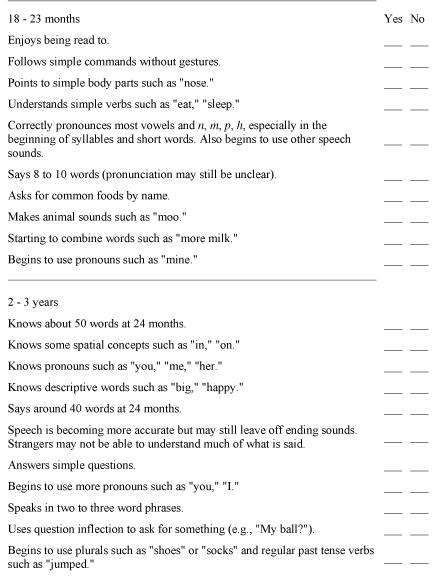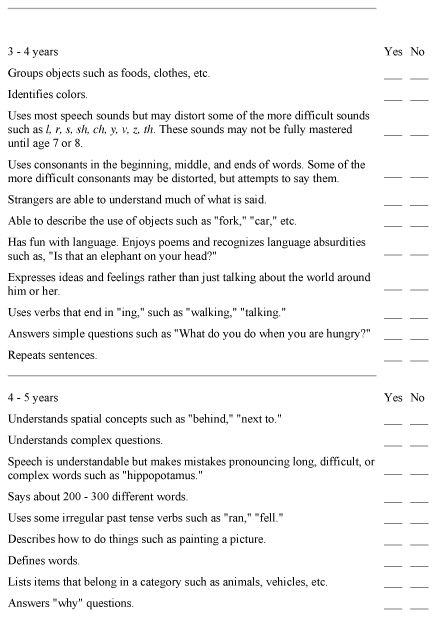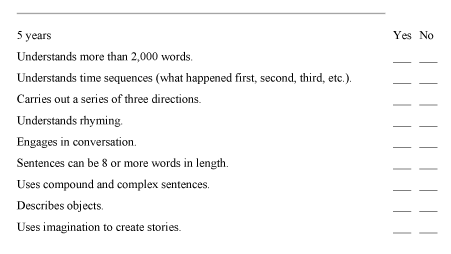Introduction
There may be times when parents become concerned with the developmental milestones of their children. Since many parents do not have a frame of reference this Parent Teacher Conference Handout will provide that reference for language development. Speech and language are tools that humans use to communicate or share thoughts, ideas, and emotions. Language is the set of rules, shared by the individuals who are communicating, that allows them to exchange those thoughts, ideas, or emotions. Speech is talking, one way that a language can be expressed. Language may also be expressed through writing, signing, or even gestures in the case of people who have neurological disorders and may depend upon eye blinks or mouth movements to communicate.
How Do Speech and Language Normally Develop?
The most intensive period of speech and language development for humans is during the first three years of life, a period when the brain is developing and maturing. These skills appear to develop best in a world that is rich with sounds, sights, and consistent exposure to the speech and language of others.
There is increasing evidence suggesting that there are “critical periods” for speech and language development in infants and young children. This means that the developing brain is best able to absorb a language, any language, during this period. The ability to learn a language will be more difficult, and perhaps less efficient or effective, if these critical periods are allowed to pass without early exposure to a language. The beginning signs of communication occur during the first few days of life when an infant learns that a cry will bring food, comfort, and companionship. The newborn also begins to recognize important sounds in his or her environment. The sound of a parent or voice can be one important sound. As they grow, infants begin to sort out the speech sounds (phonemes) or building blocks that compose the words of their language. Research has shown that by six months of age, most children recognize the basic sounds of their native language.
As the speech mechanism (jaw, lips, and tongue) and voice mature, an infant is able to make controlled sound. This begins in the first few months of life with “cooing,” a quiet, pleasant, repetitive vocalization. By six months of age, an infant usually babbles or produces repetitive syllables such as “ba, ba, ba” or “da, da, da.” Babbling soon turns into a type of nonsense speech (jargon) that often has the tone and cadence of human speech but does not contain real words. By the end of their first year, most children have mastered the ability to say a few simple words.
Children are most likely unaware of the meaning of their first words, but soon learn the power of those words as others respond to them.
By eighteen months of age, most children can say eight to ten words. By age two, most are putting words together in crude sentences such as “more milk.” During this period, children rapidly learn that words symbolize or represent objects, actions, and thoughts. At this age they also engage in representational or pretend play. At ages three, four, and five, a child’s vocabulary rapidly increases, and he or she begins to master the rules of language.
What Are Speech and Language Developmental Milestones?
Children vary in their development of speech and language. There is, however, a natural progression or “timetable” for mastery of these skills for each language. The milestones are identifiable skills that can serve as a guide to normal development. Typically, simple skills need to be reached before the more complex skills can be learned. There is a general age and time when most children pass through these periods. These milestones help doctors and other health professionals determine when a child may need extra help to learn to speak or to use language.
How Do I Know If My Child Is Reaching the Milestones?
Here is a checklist that you can follow to determine if your child’s speech and language skills are developing on schedule. You should talk to your child’s doctor about anything that is checked “no.”




Download Information
To view or print this handout you have the following options:
View or Download PDF Version of “Speech and Language: Developmental Milestones“ – PDF (Right Click and Choose Save)

